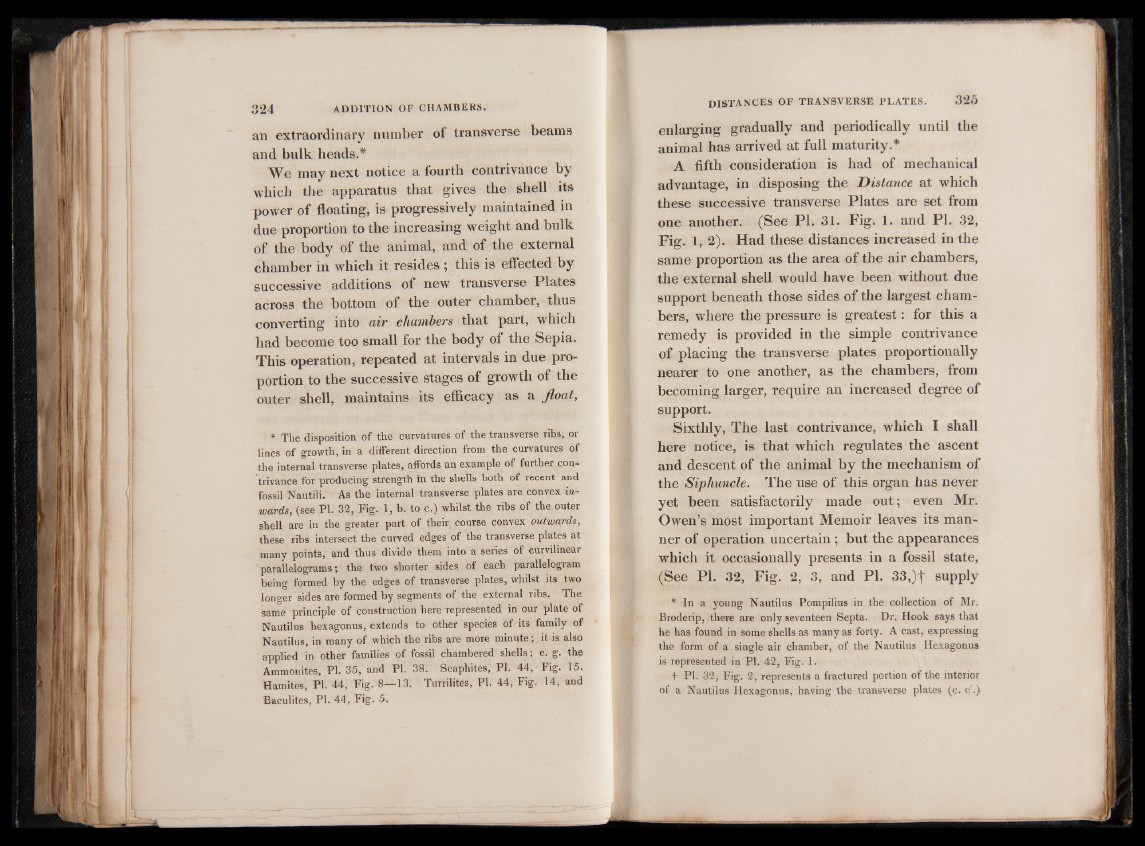
an extraordinary number of transverse beams
and bulk heads.*
We may next notice a fourth contrivance by
which the apparatus that gives the shell its
power of floating, is progressively maintained in
due proportion to the increasing weight and bulk
of the body of the animal, and of the external
chamber in which it resides ; this is effected by
successive additions of new transverse Plates
across the bottom of the outer chamber, thus
converting into air chambers that part, which
had become too small for the body of the Sepia.
This operation, repeated at intervals in due proportion
to the successive stages of growth of the
outer shell, maintains its efficacy as a float,
* The disposition of the curvatures of the transverse ribs, or
lines of growth, in a different direction from the curvatures of
the internal transverse plates, affords an example of further contrivance
for producing strength in the shells both of recent and
fossil Nautili. As the internal transverse plates are convex inwards,
(see PI. 32, Fig. 1, b. to c.) whilst the ribs of the outer
shell are in the greater part of their course convex outwards,
these ribs intersect the curved edges of the transverse plates at
many points, and thus divide them into a series of curvilinear
parallelograms; the two shorter sides of each parallelogram
being formed by the edges of transverse plates, whilst its two
longer sides are formed by segments of the external ribs. The
same principle of construction here represented in our plate of
Nautilus hexagonus, extends to other species of its family of
Nautilus, in many of which the ribs are more minute; it is also
applied in other families of fossil chambered shells; e. g. the
Ammonites, PI, 35, and PI. 38. Scaphites, PI. 44, Fig. 15.
Hamites, PI. 44, Fig. 8—13. Turrilites, PI. 44, Fig. 14, and
Baculites, PI. 44, Fig. 5.
enlarging gradually and periodically until the
animal has arrived at full maturity.*
A fifth consideration is had of mechanical
advantage, in disposing the Distance at which
these successive transverse Plates are set from
one another. (See PI. 31. Fig. 1. and PI. 32,
Fig. 1 , 2 ). Had these distances increased in the
same proportion as the area of the air chambers,
the external shell would have been without due
support beneath those sides of the largest chambers,
where the pressure is greatest: for this a
remedy is provided in the simple contrivance
of placing the transverse plates proportionally
nearer to one another, as the chambers, from
becoming larger, require an increased degree of
support.
Sixthly, The last contrivance, which I shall
here notice, is that which regulates the ascent
and descent of the animal by the mechanism of
the Siphuncle. The use of this organ has never
yet been satisfactorily made out; even Mr.
Owen’s most important Memoir leaves its manner
of operation uncertain; but the appearances
which it occasionally presents in a fossil state,
(See PI. 32, Fig. 2 , 3, and PI. 33,)t supply
* In a young Nautilus Pompilius in the collection of Mr.
Broderip, there are only seventeen Septa. Dr. Hook says that
he has found in some shells as many as forty. A cast, expressing
the form of a single air chamber, of the Nautilus Hexagonus
is represented in PI. 42, Fig. 1.
f PI. 32, Fig. 2, represents a fractured portion of the interior
of a Nautilus Hexagonus, having the transverse plates (c. c'.)